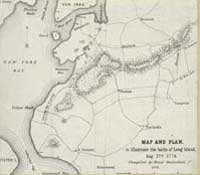|
Maps of Revolutionary War battles that were fought
in the Middle Atlantic region are highlighted here as examples.
These battles are often shown on larger regional maps as well, particularly
on Virginia and New Jersey maps of the 1770s.
The following passage from the Historical Guide
to the City of New York, compiled by the City History Club of New
York in 1909, vividly depicts the Battle of Long Island, a map and
battle plans for which are shown here.
“The British, landing on Long Island in August, 1776,
found that the Americans had covered three of the four roads leading
to Brooklyn, where fortifications had been thrown up from Gowanus
to Fort Putnam, now fort Greene. The fourth, a roundabout way on
the Jamaica Road, had been neglected and the strategic importance
of this pass was at once recognized by the British. General Howe,
sending two detachments under Grant by the shore road to Gowanus,
and a column of Hessians under DeHeister by the middle pass, himself
took the Jamaica Road.
The battle began on August 27, when
Grant's men met the Americans under Stirling, and pushed them back
toward the position (now covered by Greenwood Cemetery) occupied
by Sullivan. In the meantime Howe, on reaching Howard Half Way House
on the Jamaica Road, turned sharply to the west and soon came unexpectedly
on the rest of Sullivan's men. The Hessians, who had hitherto remained
inactive, then pushed hard on the front and the Americans were forced
to retreat, Sullivan being captured. Immediately Howe sent forward
troops against Stirling, while Grant, made aware of this movement,
pressed heavily against them and here again the Americans, caught
in a trap, were compelled to retreat, losing Stirling. The day of
disaster to the Americans closed with an exhibition of devoted bravery
on the part of the Maryland regiment who held back the British until
their struggling companions could reach safety. The British did
not push the advantage gained and thus gave Washington opportunity,
under cover of a fog, to transport all his men safely to New York."
|





